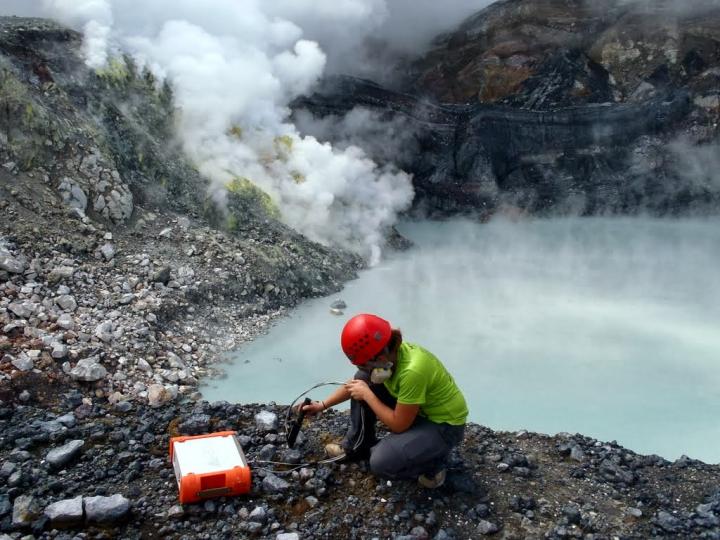Microbes living in a toxic volcanic lake could hold clues to life on Mars

Sarah Black, who recently completed her Ph.D. in Geological Sciences at CU Boulder, collects water samples from Laguna Caliente. Credit photographer: Brian Hynek
The team, led by CU Boulder Associate Professor Brian Hynek, braved second-degree burns, sulfuric acid fumes and the threat of eruptions to collect samples of water from the aptly-named Laguna Caliente. Nestled in Costa Rica's Poás Volcano, this body of water is 10 million times more acidic than tap water and can reach near boiling temperatures. It also resembles the ancient hot springs that dotted the surface of early Mars, Hynek said.
The Costa Rican lake can support life–but only barely. Hynek and his colleagues found microbes belonging to just a single species of bacteria in the lake water, a rock-bottom level of diversity.
“Even in an extremely harsh environment, there can still be life,” said Hynek of the Laboratory for Atmospheric and Space Physics and the Department of Geological Sciences. “But then there's very little life. Mars was just as extreme in its early history, so we should probably not expect to find evidence of large-scale biodiversity there.”
Laguna Caliente is chaotic, with water temperatures that can swing wildly in the span of hours and magma channels running under the lake that kick off frequent, geyser-like eruptions.
“We're at the limits of what life on Earth can tolerate,” Hynek said. “It's not somewhere you want to spend a lot of time because you'd probably get covered in boiling mud and sulfur from the eruptions.”
To search for living organisms in this “fringe” environment, the researchers scanned samples of lake water for DNA. In research published this month in Astrobiology, they found the signature of one species of bacteria belonging to the genus Acidiphilium–a group of microbes that scientists have previously seen in toxic drainage from coal mines and other harsh locations.
“It's not uncommon to find an environment with no life, say in a volcano that's self-sterilizing,” Hynek said. “But to find a single type of organism and not a whole community of organisms is very, very rare in nature.”
If life did evolve on Mars, Hynek said, it would likely have survived in ways similar to the lake's bacterium–by processing the energy from iron- or sulfur-bearing minerals. Hynek has spent much of his career searching for places on Earth today that look like Mars did nearly four billion years ago, when liquid water was plentiful on the surface.
It's a hard task: Rampant volcanism during that period created volatile and mineral-rich pools of water, giving rise to “Yellowstones all over Mars,” Hynek said.
In 2020, NASA is planning to send the Mars 2020 Rover to the Red Planet to hunt for fossil evidence of life. Hynek said that they should look first at these “Yellowstones.”
###
Co-authors on the new study include CU Boulder undergraduate student Monique Antunovich who graduated in 2017; Karyn Rogers of the Rensselaer Polytechnic Institute in Troy, New York; Geoffroy Avard of the National University of Costa Rica; and Guillermo Alvarado of the University of Costa Rica.
Media Contact
All latest news from the category: Physics and Astronomy
This area deals with the fundamental laws and building blocks of nature and how they interact, the properties and the behavior of matter, and research into space and time and their structures.
innovations-report provides in-depth reports and articles on subjects such as astrophysics, laser technologies, nuclear, quantum, particle and solid-state physics, nanotechnologies, planetary research and findings (Mars, Venus) and developments related to the Hubble Telescope.
Newest articles

NASA: Mystery of life’s handedness deepens
The mystery of why life uses molecules with specific orientations has deepened with a NASA-funded discovery that RNA — a key molecule thought to have potentially held the instructions for…

What are the effects of historic lithium mining on water quality?
Study reveals low levels of common contaminants but high levels of other elements in waters associated with an abandoned lithium mine. Lithium ore and mining waste from a historic lithium…

Quantum-inspired design boosts efficiency of heat-to-electricity conversion
Rice engineers take unconventional route to improving thermophotovoltaic systems. Researchers at Rice University have found a new way to improve a key element of thermophotovoltaic (TPV) systems, which convert heat…



